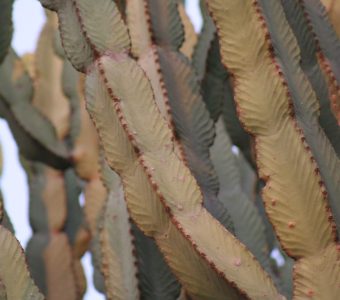


Botanical Name: Euphorbia ingens
Common Name: Candelabrum Tree, Kilota, Liandandu, Chinsembu, Mlangali, Chisu
Plant Family: Euphorbiaceae (Euphorbia Family)
Growth Form, Habitat and Distribution: A deciduous massive succulent tree with a circular trunk. The upper trunk becoming 4-sided with broad wings and short, paired spines. The candelabrum forms a dense, rounded crown. If damaged, it exudes copious toxic, white latex. Occurs widely across Zambia, often on termite mounds and in Mopane, Munga and Miombo woodland, Itigi thicket and in rocky areas.
Size: Height up to 20m, spread 6 to 10m
Bark: Pale to dark grey-brown with deep transverse fissures with vertical flaking.
Leaves: Small, pale green and fleshy, appearing briefly at the ends of branches with the beginning of the rains, but falling after a few weeks.
Flowers: Small (6 to 10mm) yellow-green on the winged margins of terminal branch nodes, March to August.
Fruit: A globose, green 3-lobed (1.5cm) capsule becoming red-brown, maturing July to September releasing 2 round seeds.
Uses: The latex is toxic but has been used in traditional medicine and as a bird lime and fish poison. The stem produces a tough, light wood that is sometimes used for building and burned to create a fertilizer.
